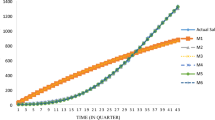Abstract
It is widely believed that products are diffusing within the marketplace at an increasing pace. To empirically investigate this belief, diffusion model parameters are estimated for a large set of consumer durables in the home appliance industry, Multiple measures of diffusion rates are then computed and compared across products by year of introduction. Contrary to conventional wisdom, no statistical relationship is found. These results suggest that diffusion rates havenot been systematically accelerating over time.
Similar content being viewed by others
References
Alsop, R. (1986). “Companies Get on Fast Track to Roll Hot New Brands,”Wall Street Journal, July 10, 25.
Bass, F. (1969). “A New Product Growth Model for Consumer Durables,”Management Science 15 (January), 215–227.
Clark, K., and T. Fujimoto. (1989). “Lead Time in Automobile Product Development Explaining the Japanese Advantage,”Journal of Engineering and Technology Management 6, 25–58.
Clark, W., H. Freeman, and D. Hanssens. (1984). “Opportunities for Revitalizing Stagnant Markets: An Analysis of Household Appliances,”Journal of Product Innovation Management 4, 242–254.
Dumaine, B. (1989). “How Managers Can Succeed Through Speed,”Fortune, February 13, 54–59.
Fisher, J., and R. Pry. (1971). “A Simple Substitution Model of Technological Change,”Technological Forecasting and Social Change 3, 75–88.
Fraker, S. (1984). “High Speed Management for the High Tech Age,”Fortune, March 5, 62.
Gold, B. (1987). “Approaches to Accelerating Product and Process Development,”Journal of Product Innovation Management 4 (June), 81–88.
Grubler, A. (1991). “Long Term Patterns and Discontinuities,”Technological Forecasting and Social Change 39, 159–180.
Haines, D., R. Chandran, and A. Parkhe. (1989). “Winning by Being First to Market ... or Second?”Journal of Consumer Marketing 6 (Winter), 63–70.
Jain, D., and R. Rao. (1990). “Effect of Price on the Demand for Durables: Modeling, Estimation and Findings,”Journal of Business and Economic Statistics 8 (April), 163–170.
Kamakura, W., and S. Balasubramanian. (1988). “Long Term View of the Diffusion Durables: A Study of the Role of Price and Adoption Influence Processes Via Tests of Nested Models,”International Journal of Research in Marketing 5, 1–13.
Levitt, T. (1965). “Exploit the Product Life Cycle,”Harvard Business Review 43 (November–December), 81–96.
Mahajan, V., and R. Peterson. (1978). “Innovation Diffusion in a Dynamic Potential Adopter Population,”Management Science 28 (September), 1589–1597.
Olshavsky, R., and D. Granbois. (1979). “Consumer Decision Making—Fact or Fiction?”Journal of Consumer Research 6 (September), 93–100.
Olshavsky, R. (1980). “Time and the Rate of Adoption of Innovations.”Journal of Consumer Research 6 (March), 425–428.
Polli, R., and V. Cook. (1969). “Validity of the Product Life Cycle,”Journal of Business 42 (October), 385–400.
Pry, R. (1974). “Forecasting the Diffusion of Technology,” in H. Davidson, M. Cetron, and J. Goldhar (eds.),Technology Transfer Leiden: Nordhoff, 227–246.
Qualls, W., R. Olshavsky, and R. Michaels. (1981). “Shortening of the PLC—An Empirical Test,”Journal of Marketing 45 (Fall), 76–80.
Rogers, E., and F. Shoemaker. (1971).The Communication of Innovations New York: The Free Press.
Rosenau, M. (1988). “Speeding Your New Product to Market,”Journal of Consumer Marketing 5 (Spring), 23–36.
Schmittlein, D., and V. Mahajan. (1982). “Maximum Likelihood Estimation for an Innovation Diffusion Model of New Product Acceptance,”Marketing Science 1, 57–78.
Schnaars, S. (1986). “When Entering Growth Markets, Are Pioneers Better than Poachers?”Business Horizons 29 (March–April), 27–36.
Schultz, S., and S. Rao. (1986). “Product Life Cycles of Durable Goods for the Home,”Journal of the Academy of Marketing Science 14 (Spring), 7–12.
Srinivasan, V., and C. Mason. (1986). “Nonlinear Least Squares Estimation of New Product Diffusion Models,”Marketing Science 5, 169–178.
Stalk, G. (1988). “Time—The Next Source of Competitive Advantage,”Harvard Business Review, July–August, 41–51.
Stalk, G., and T. Hout. (1990).Competing Against Time New York: The Free Press.
Toffler, A. (1970).Future Shock New York: Random House.
Toffler, A. (1980).The Third Wave New York: William Morrow.
Von Braun, C. (1990). “The Acceleration Trap,”Sloan Management Review, Fall, 49–58.
Author information
Authors and Affiliations
Additional information
Thanks are extended to Vithala Rao and Donald Lehmann (editor) for their comments on an earlier draft, and to Howard Susskind and Eric Olson for their assistance with the data collection and analysis.
Rights and permissions
About this article
Cite this article
Bayus, B.L. Have diffusion rates been accelerating over time?. Marketing Letters 3, 215–226 (1992). https://doi.org/10.1007/BF00994130
Received:
Revised:
Issue Date:
DOI: https://doi.org/10.1007/BF00994130




